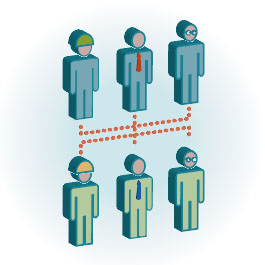Location and situational awareness
Tracking technologies that empower your business
Information is power
Trackable’s™ tags and sensors stream the information you need in real-time.
Trackr™ translates the streaming data into analytical insight.
TRACK OBJECTS
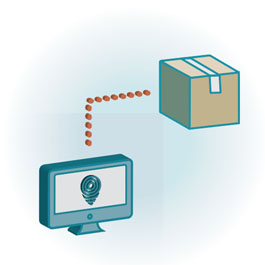
Know where assets, tools, parts and other objects are located. Manage inspections and calibrations. Improve asset utilization, enhance efficiencies and increase profitability.
TRACK PEOPLE
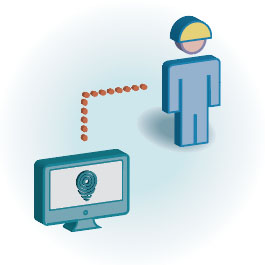
Know where workers are located real-time, passively. Better leverage worker productivity and ensure worker safety. Account for and muster workers on and off site.
TRACK PROCESSES
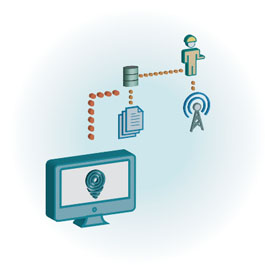
Utilize tracking and IoT technologies to reengineer processes based on location and situational awareness, with predictive analytics and task management.
The information you need, when you need it
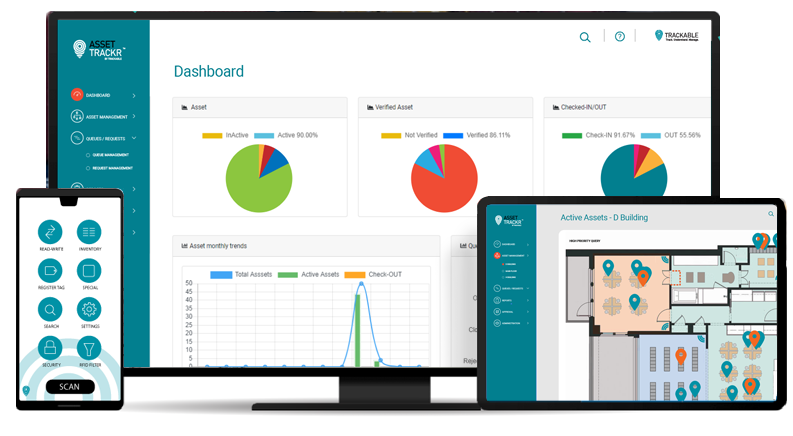
Trackr™ is a powerful tracking platform available at your fingertips via phones, tablets, computers and consoles. Trackr™ provides layers of knowledge and understanding about all of your objects, people and processes...tailored to the information most important to your enterprise.

The Trackable™ Platform
Dashboards
- Dashboards organize critical organizational data in visual graphs, charts and tables for fast and easy analysis
- A consolidated data view across your organization
- Timesaving efficiency through easy to interpret visual overviews and summaries
- Better decision-making through key data points
- Improved forecasting and customer analytics
Database searches
- Trackr™ is designed to your requirements, so that you have the information you need to understand your business more deeply and broadly than previously possible
- Robust database including unlimited data fields
- Query based on data, meta-data and date ranges
- Query based on status, location and tasks
- A complete view of your objects and personnel
- Export queries to spreadsheets or other apps
Reporting
- Trackr™ provides enhanced organizational awareness through data capture through tracking and IoT technologies, enabling expansive and deep reporting capabilities. Trackr™ provides you the data that you need to better understand your business with strategic context.
- Extensive list of standard reports available out-of-the-box
- Unlimited custom reports based on the unique requirements of your business
- Create ad-hoc reports in seconds
- Leverage the full power of SQL queries and multi-table joins
Trackr™ software, tracking and IoT puts you back on track
Collaborative solution design
Trackable assigns a team of analysts and technical resources to work with your staff in understanding your business, understanding what Trackr™ can do for you, and to establish the blueprint of the system that will make your organization most effective. This process establishes a software configuration and technology integration project plan that ensures project and operational success.
Iterative software configuration
Based on the solution blueprint and project plan resulting through our collaboration and discovery process, Trackable’s technical team configures Trackr™ software to fulfill your exacting data, tracking, workflow, security and reporting requirements. Through periodic web-meetings and software demonstrations, your staff sees the software’s design real-time ‘as it is evolving’ to provide feedback and further the solution development. Trackr™ is implemented for you only when you say ‘it’s perfect, let’s go!’.
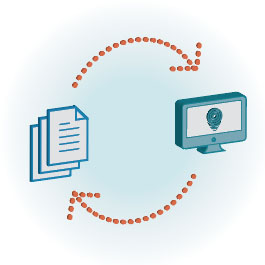
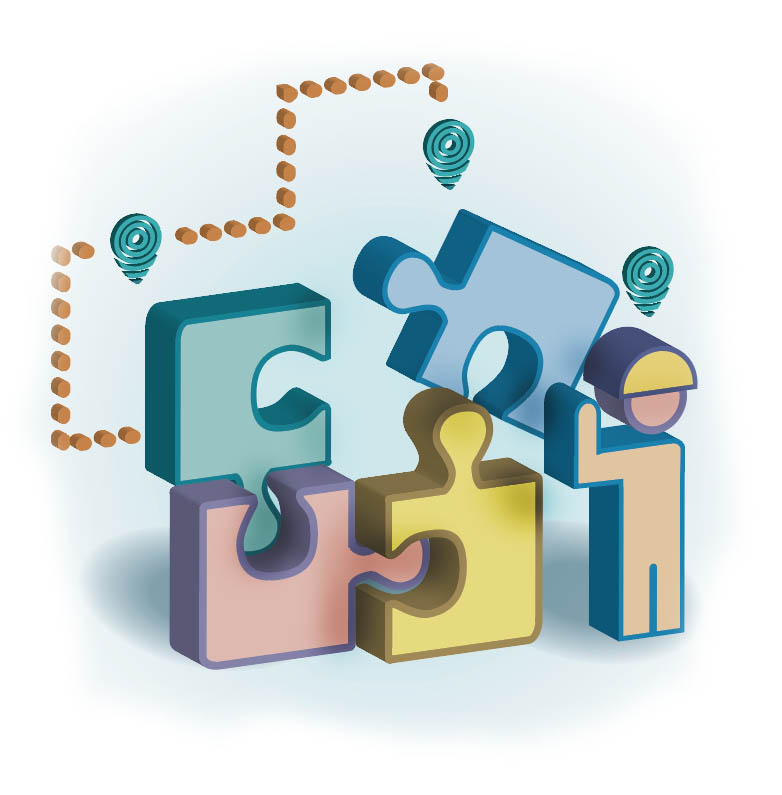
Software synchronization and systems integration
Trackr™ can be easily and fully integrated with your backend software, like an ERP or other core processing system(s), providing real-time, bi-directional data flow between Trackr and your existing solutions.
Trackr™ also can be integrated with existing access control, video or other systems that may already be in place, or which will be implemented along with Trackr.
Trackr™ supports file transfers, FTP and API-based software and systems integration.
Integrate the right tracking technologies
Integrate mobile computing, barcoding, RFID and long-range tracking technologies to provide you with location and situational awareness. As tags are detected the place, person and time/date automatically update Trackr™ software, triggering automated analytics. We help you make sure that Trackr™ produces the data that you need, when you need it, how you need it and where you need it.
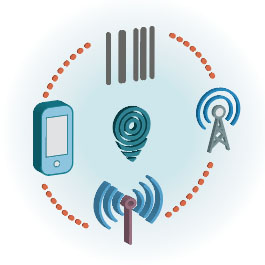
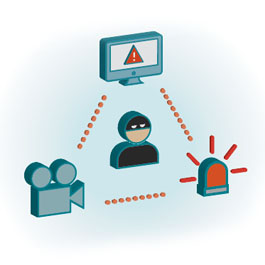
Incorporate security
Trackr™ integrates with you access control systems, including bi-directional data sharing. Trackr™ events are time/date stamped and linked to time/date stamps in video surveillance systems.
Trackr™ supports network alarms/flashing lights and intrusion detection systems for fully integrated tracking and security.
Implementation and training
Trackr™ is configured according to your specific software design, database synchronization and systems integration requirements, so that it is ready to perform at top speed from day-one. We make sure that your staff can fully, and easily, utilize the software to its fullest capabilities.
Once Trackr™ has been installed and tested, our engineers come to your site and work with your team and our local reseller’s team to physically install hardware and implement tagging systems. Then we train your staff on all aspects of the systems usage and internal support.
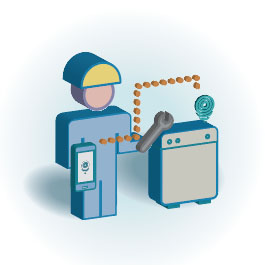
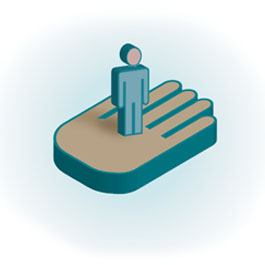
Ongoing support
Trackr™ gets the job done for your organization, but it’s only as good as is your staff’s ability to fully utilize the solution. All too often organizations are only able to utilize a fraction of an application’s capabilities. We will help make sure that you can leverage all of Trackr’s capabilities so that your business can thrive.
In addition to Trackable’s direct support, you will also receive full service locally from Trackable’s local distributor. The best of both worlds: Trackable’s world class expertise and your dedicated local Trackr support agent.
We keep your staff fully capable and your system running smoothly and delivering the results that you expect.
Reengineer your enterprise with Trackr™
Trackr™ FAQs
Absolutely. Trackr’s server stack is based on the best, most widely adopted software development tools and technologies in the industry today, including:
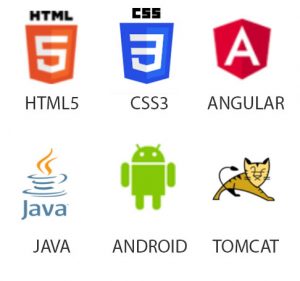
Trackr is cross-platform supporting both Open Software and Microsoft technical environments, as well as support for Oracle, IBM and similar systems.
Windows10
SQL Server
Linux
Trackr is flexible and supports both on-premise (stand-alone/LAN/WAN) or cloud deployments.
Trackable supports both investment strategies. Both local server and cloud deployments can be based on one-time ‘perpetual’ software licenses, and is the most common method of procurement by our customers. Trackr is also available subscription-based, whereby the initial investment is lower upfront and includes periodic billing on an ongoing basis.
Yes. Trackr is designed for flexible integration with your existing software platforms in the manner that your IT staff prefers.
File Transfer Protocol
Application Programming Interface (API)
COTS Commercial-off-the-shelf-Software
Trackr is COTS Commercial-off-the-shelf-Software. COTS means that the software is a single code-base that is continually advanced based on Trackable’s internal development initiatives, and incorporates any enhancements programmed for new customers. All of Trackr’s features and functions are available to each new customer out-of-the-box. Trackr is rapidly and inexpensively configured to your exacting data, workflow, tracking and security requirements. COTS software ensures deliverables and mimizes project/solution risks, because the software has been successfully deployed for many prior clients. And, because Trackr is designed for your specific processes and procedures, Trackr is easy-to-learn and easy-to-use.
Custom Developed Software
Custom developed software is rife with risks and an unknown outcome, where COTS software is already proven with a fully known outcome known from day one. Custom software is typically priced based on ‘time and materials’, meaning that costs are open-ended and unpredictable, all too often with busted budgets. Further, the programmers that are utilized to develop the software are typically the type of workers that go assignment to assignment and cannot be counted on for the long term to continue to support the app and customers utilizing the app, producing potential solution collapse.
‘Canned’ Software
Canned software is software that has been developed with a rigid design and limited flexibility for modification. Whereas COTS software is designed for your specific requirements and ‘how you want and need to do business’, canned software is often highly complex with many features and workflows that don’t even apply to your business. COTS is designed specific to your needs, flows and processes, so is easy-to-learn and easy-to-use, with a high probability of success for your enterprise. Canned software is difficult to learn or use, is difficult and expensive to modify with high development and consulting costs.
Unlimited data views (templates).
A data view is a set of data / meta-data fields and related software functions that are tailored for tracking different types of objects and people. Examples include:
Personnel Files
Contracting Files
Facility Assets
Industrial Assets
Utility Assets (HVAC, etc.)
Motorized Assets
Vehicles
Personnel
Visitors
Industrial Parts (maintenance)
Raw Materials and Supplies
Inventory
Industrial Tools
Surgical Tools
Police Evidence
Weapons, Gear and Ammo
Books and Judgements
Art and Artifacts
Trackr supports unlimited data views within a single database instance.
Unlimited data fields for each data view
Each data field can be configured as:
Keyboard input (text field)
Select from List
Popup Calendar
Checkbox
Unlimited Task Lists
Task lists are placeholders for objects or people that require attention and/or processing, for example:
File Requests
Files Ready for Pickup
Files Ready for Archiving
Files Ready for Archiving
Asset Requisitions
Asset Reservations
Assets Ready for Pickup
Asset Inspections Due
Asset Calibrations Due
Asset Maintenance Due
Asset Return-to-Factory for Service
Tool Reservations
Personnel Authorizations Due
Personnel Certifications Due
….Any Task or Queue that you can Imagine
Fast and Easy Database Searches
Search based on one or more data and/or meta-data fields
And by date or date range
And by Location
And by Status
Wildcard searches based on predefined ID (# + name + description, etc.)
SQL queries for producing reports
Tracking – Workflow
Tracking screen inputs can be made with:
Keyboard
Touch monitor
Barcode scan
RFID scan
Enter or input Object ID’s
Supports singular and batch processing (one or many objects)
Destination can be scanned, input by keyboard/touch or selected-from-list
Define Reason object is being transferred by scan, keyboard/touch or list
Rapid, accurate Check-in and Check-out
Optionally capture electronic signature to validate event/transaction
Status can be scanned, input by keyboard/touch or selected-from list
Encode RFID tags with your Unique ID #
Associate factory, native RFID tag # with your Unique ID in Trackr database
Optionally print report showing transaction details
Export transactional data to a backend database/software package
Audit Trail Records (chain-of-custody / transactional history)
Every usage of the software and event captured by Trackr establishes unique transactional history records that govern objects from origination through final disposition, and personnel from hiring to final disposition. Including:
Login
Record view
Record update
Add record
Delete/archive record
Check-in (Return)
Check-out (Issue)
Transfers
Requests
Addition to Task Lists
Task List processing
Remote tracking (RFID, etc.)
Tracking via mobile scanner inventory / audit
Status update
Log-off
Unlimited Standard and Custom Reports
Trackr includes a tag processing engine that enables easy support for any type of tracking technology, including:
1D and 2D barcodes
Barcodes are scanned one-at-a-time from close proximity, generally < 1’.
UHF RFID
UHF RFID tags are generally utilized to create a globe of radio waves approximately 10’ and up to 40’ and are typically positioned at doorways, passageways and other choke points. UHF mobiles scanners have a range of approximately 20’ depending on size of tag and environment.
How does a UHF RFID System Work?
The RFID reader emits radio waves of specific frequencies through RFID antennas. The waves “give energy” to the tags so that they can communicate by emitting a unique ID. They do not need batteries and can be used for many years. The reader processes the data so that we can integrate them into our application and give them meaning. The typical reading range is 0-12 meters. Gen2 UHF RFID systems consist of: readers, antennas, printers, and RFID tags or labels. In this article I will define with a brief explanation each of the main elements when implementing an RFID project.
RFID ANTENNAS
RFID Antennas are responsible for emitting and receiving waves that allow us to detect RFID chips. When an RFID chip crosses the antenna field, it is activated and emits a signal. The antennas create different wave fields and cover different distances.
Antenna Type: Circular polarization antennas work best in environments where the orientation of the tag varies. Linear polarization antennas are used when the orientation of the tags is known and controlled and is always the same. NF (Near Field) antennas are used to read RFID tags within a few centimeters.
Overcast angle and gain: Using antennas with gains of between 8.5-10 dbi or more, will allow us to emit more power and obtain a higher reading ratio. The angle of opening depends on the area to be covered, for example: 70 °, 100 °, etc. The more overture the antennas have, the less detection distance.
Number of Antennas: Standard high-performance readers have 2 ports, 4 ports or 8 ports. The number of antennas is usually chosen according to the reading space we want to detect or the density of tags to read. Typically used is 2 or 4 port fixed readers. Some brands have multiplexers that allow us to connect up to 32 antennas in the same reader.
RFID READERS
There are multiple types of readers; Fixed RFID, portable rfid readers, rfid readers for Smartphone and USB readers. To read a high density of tags or requirements of 100% accuracy in detection, the best fixed RFID readers are: Impinj R420, ThingMagic M6e, Zebra FX9500. And if we need to use portable readers, we recommend the Zebra MC9190, Impinj AB700 Zebra RFD8500. To choose the right reader, we have to take into account several factors:
Reading area: Fixed readers serve mainly to cover a specific area: one point by a doorway, a machine, on a conveyor belt, in a crate, etc. Mobile readers allow us to read while we move and to perform inventories or search for RFID tags that we do not see.
Ratio of reading: the emission power and reading capacity requirements are determined by the number of tags to detect in a specific time. The most complex applications are those where there is a high density of tags, liquids or metal products. The maximum reading power is marked by the regulation allowed in each country or zone according to the type of frequency (ETSI, FCC).
The type of rfid reader: many times the question is whether to use a fixed reader or a portable reader. This factor depends on the application. For example, if we are in a store or warehouse where we need to make inventories and movements, it is convenient to use a portable terminal. If the reading area is fixed, it is convenient to install a reader that covers the area and leave the task automated. For example to detect pallets or products in shipping areas.
USB Readers: These readers give excellent results when we need to record or read very few tags at different points during the manufacturing processes or for validation of documents in offices. Two clear examples are the Nordic Stix and the ThingMagic USB Reader.
RFID LABELS AND TAGS
The essential factors are: size, orientation, reading angle, area the are located and the type of chip.
Size: the size of the chip is a very important factor, for the simple reason that the more antenna the RFID tag, has the better the sensitivity and the detection. Whether the response of the tag is always the same or very similar every time it is detected, we are able to then develop reliable and robust applications. The antennas are usually made of aluminum or copper.
Orientation and reading angle: If we have circular antennas we do not have to worry about much about orientation. The orientation of the tag is worrisome when we try to detect them with linear antennas. In this case, we must test if the best position of the tag is vertical or horizontal, as is the case when using the ShortDipole tag. There are omni directional antennas with two dipoles, such as FROG 3D and WEB, that allow us to detect the tags regardless of their orientation. The reading range of these is usually lower by the composition of the antenna.
Integrate Circuit (IC): These are the internal chips of the RFID tag. The most common are the Impinj Monza, NXP, and Higgs. There are IC’s with more or less memory, from 96 bits to 512 bits. They have additional memories, EAS alarm system, ability to lock with passwords, etc. There are also IC’s that combine both RFID / NFC technologies on the same chip. When more memory is required we can put it in an external database and associate an ID that identifies the chip.
Location area: it is very important to take into account where the applied tag will go so that the rfid solution is successful and meets the necessary reading ranges. Keep in mind that metal bounces the RF waves and that water absorbs them. There are solutions for metal labels that allow us to place the tags on the metal and detect them correctly. The material and adhesive to be used are determined by environmental factors such as indoor or outdoor, high temperatures, as is the case in pharmaceuticals tracking or food tracking as well as other special applications.
Long Range Tracking with Active RFID, UWB, LoRa and Bluetooth/BLE
Trackable is a strategic partner and integrator of ELA Innovations and other long range tracking technology vendors, fully integrated with Trackr software.
Whereas UHF RFID is suited for short-range, small zone tracking only when tagged objects or people pass in relatively close proximity to a tag reader/interrogator, long range tracking technologies provide real-time, everywhere tracking of people and objects.
Long range tracking technologies have a range of 100’s of meters or feet and up to multiple miles, utilizing tag interroragor hardware that transmit long range signals. Long range tags include a battery and transmit their location (beacon) on a timed interval for real-time tracking indoors and outdoors.
GSM/GPS/5G
Whereas long range tracking technologies are generally restricted to less than 1,000 meters, GSM/GPS tags track tagged people and objects real-time wherever they are located worldwide.
5G is introducing a new concept in IoT, by being able to track objects and people by all 5G phones and devices in proximity. As such, 5G phones and devices create an organic network worldwide.
Long range tracking technologies generally do not utilize mobile scanners, because all tagged objects and people are passively and automatically tracked wherever they located, all-the-time, real-time…precluking the need for the use of mobile scanner for ad-hoc scanning. However with barcoding and UHF RFID, mobile scanners are a critical element of tracking and accountability solutions. Trackr supports barcode and UHF RFID mobile scanners, including Smartphones and Tablets.
Trackr Mobile can function as a stand-alone solution that does not require integration with Trackr or any backend database system, and also can be utilized fully integrated with your existing software application(s) and/or Trackr. Standard capabilities include:
Find a single object
Search for multiple objects concurrently
Inventory objects at locations
Audit objects at locations and adjudicate:
Expected and found
Expected and not found
Unexpected and found
Unknown tag
Encode tags with existing Unique ID
Associate native tag RFID #’s with your Unique ID’s
Absolutely and with full confidence.
If Trackr is installed on local servers within your enterprise, the software is behind your firewalls and inherits all of the security capabilities and mechanisms that your organization already maintains or may implement in the future.
If Trackr is deployed via the cloud, it taps into all of the vast and sophisticated security of Amazon Cloud.
Trackr was and is designed for maximum scalability.
Object and People Types
Trackr supports unlimited types of objects and people within a single database instance. Examples include:
Personnel files
Contracting files
Facility Assets
Industrial Assets
Utility Assets (HVAC, etc.)
Motorized Assets
Vehicles
Personnel
Visitors
Industrial Parts (maintenance)
Raw Materials and Supplies
Inventory
Industrial Tools
Surgical Tools
Police Evidence
Weapons, Gear and Ammo
Books and Judgements
Art and Artifacts
Tracking Technologies
Trackr was and is developed with a robust tag data processing engine that is adaptable to any tracking technologies, including:
1D barcodes, 2D barcodes and QR codes
NF and UHF RFID
Bluetooth, Active RFID, LoRa RFID and UWB RFID
GSM, GPS and 5G
Security Technologies
Trackr was and is developed with recognition that tracking technologies and security mesh together as required for customer’s tracking and security requirements. Supported security technologies include:
Turnstiles and Gates
Access control systems
Video surveillance systems
Intrusion detection systems
Trackr is available worldwide to any country that has not been designated by the U.S. Department of State as an adversarial country.
Trackr was designed to support any language required by Trackable customers. Trackr provides a 2-column table with Trackable nomenclature in first column and in the second column foreign language matching nomenclature is entered. As such, all Trackr screens, messaging and windows render in any language of choice.
You can count on Trackable's experience
U.S. Dept. of State: object management worldwide
Implemented database management and tracking system for:
¤ Tracking passports received and passport bins through processing steps
¤ All weapons, gear and ammo issued to agents and embassies worldwide
¤ Tracking system for secret records for the Office of the Inspector General
Chevron: worker safety, accountability and mustering
Though Chevron had mustering protocols, when an actual chemical spill occurred, it took hours to produce an accurate Muster Report and hours more to find the missing person, who had already died from chlorine ingestion. Implemented:
¤ Long range RFID battery tags to track all workers across the onshore refineries 22+ acres of operation.
¤ Strategically placed long range RFID readers to detect all workers, everywhere, real-time.
¤ Command center software utilized by on-premise security team to generate and manage muster reports.
Miami Museum of Modern Art: art and artifacts tracking, accountability and security
Museums maintain a vast majority of their art and artifacts in storage, rotating in and out of display areas over time and lending to other institutions. The museum was losing track of art and artifacts due to manual registries, inefficient processes and a lack of modern tracking technologies. Trackable staff delivered:
¤ A database of all art and artifacts owned by the museum and the current location of each
¤ RFID technology that automatically tracked art and artifacts exiting or entering storage areas
¤ Mobile RFID scanners to inventory art when on display and to find missing art in storage
U.S. Air Force: weapons, gear, ammo and personnel tracking
The U.S. Dept. of the Air Force, like almost all military and police worldwide, kept track of weapons, gear and ammo with forms that were used at the time of issue or return. Widespread inefficiencies led the Air Force to Trackable staff to collaborate with top ranking Air Force officials to design modern solution:
¤ Tag weapons, gear and ammo with RFID tags hidden within weapon grips
¤ Track movements at computers and at issue-return windows
¤ Authenticate personnel, ensure current certifications and track custody with electronic signatures
United Arab Emirates Ministry of the Interior: file jacket tracking and record management
The United Arab Emirates Ministry of Interior maintains large numbers of files and documents. Systems and processes were inefficient leading to delays in accessing needing files and missing documents, leading to engagement of Trackable staff to:
¤ Establish records management computerized registry and RFID tags on all files
¤ RFID antennas along all hallways and at fileroom doorways to passively track files
¤ RFID antennas and alarms at building exits to prevent the unauthorized removal of files
E-Durables: manufacturing automation
Implemented production automation and IoT end-to-end goods and process traceability for one of the world’s leading OEM air conditioner manufacturers:
¤ Six (6) assembly lines and manufacturer of 4,000+ air conditioners per day
¤ Flexibility and tuning across fifteen (15) brands and hundreds of models
¤ IoT automation increased efficiencies, minimized labor costs and reduced customer complaints, leading to customer retention and outperformance of competitors
Trinidad and Tobago Police Services: evidence and seized property management
Trinidad and Tobago Police Services was storing and managing evidence and seized property across 100+ police precincts. There were prevalent challenges keeping track of crime scene evidence and there were concerns relating to corruption. Utilized Trackable’s staff to implement new state-of-the-art RFID solution:
¤ Established an array of multiple RFID labels for tagging various evidence-types
¤ Required personnel authentication and electronic signatures for transfer-of-custody
¤ RFID antennas and alarms prevent unauthorized evidence movement or exits
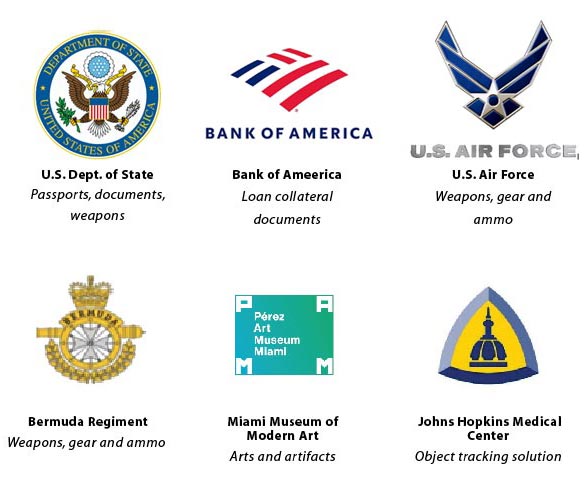
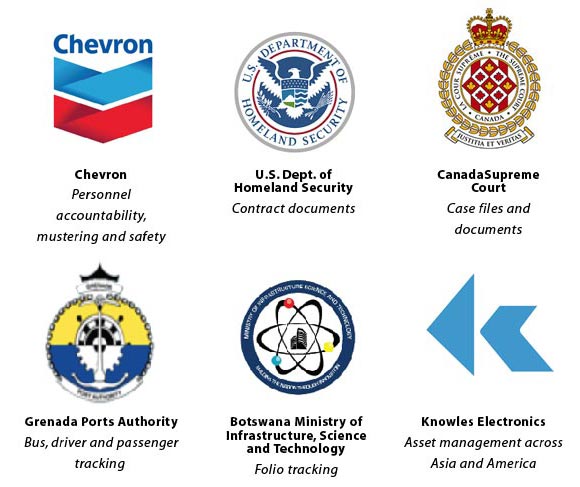
The Trackable solution
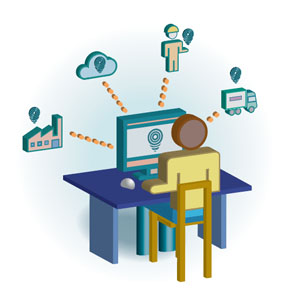
Trackr™ fundamentally incorporates an understanding of your business, its needs and how to improve performance through software, tracking and IoT.
It seamlessly integrates with your backend databases and applications, with bi-directional data interchange.
Proven success. Turn-key implementations. Studios training. Rigorous ongoing support. Your success is our only objective.
Click here to arrange a free consultation.
Contact us
Customer Service: +1 941 946-1468
Offices and partners worldwide
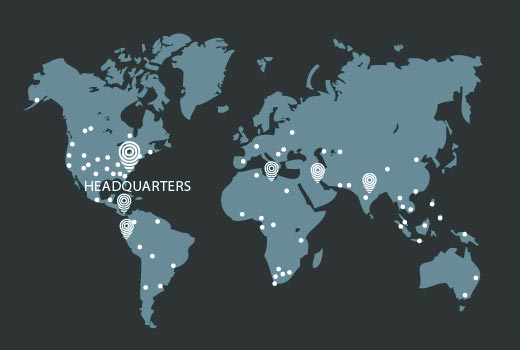
Trackable IOT
Address:
1680 Fruitville Road, Suite 512
Sarasota, Florida 34293 USA
Email us:
info@trackableiot.com


